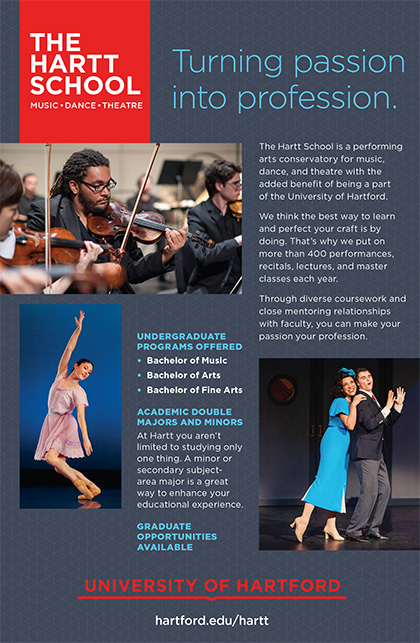World Premiere: January 5, 1932
Most Recent HSO Performance: December 1983
Instrumentation: Solo piano, 3 flutes with third flute doubling on piccolo, 2 oboes, English horn, 2 clarinets, E-flat clarinet, bass clarinet, 2 bassoons, contrabassoon, 4 horns, 3 trumpets, 3 trombones, tuba, timpani, bass drum, cymbals, snare drum, triangle, tamtam, woodblock, harp, and strings: violin I, violin II, viola, cello, and bass
Duration: 19'
Maurice Ravel made a triumphant tour of America as pianist and conductor in 1928. Plans were begun almost immediately for a second foray into the New World, and Ravel started work on a piano concerto in 1929 that was to be the centerpiece of the venture. While he was at work on what became the Concerto in G, however, he was asked to compose another concerto by the pianist Paul Wittgenstein, brother of the eminent Austrian philosopher, Ludwig, who was determined to continue his concert career despite the loss of his right arm during the First World War. Wittgenstein had transcribed several piano works for his own performance for left hand alone, and had commissioned new pieces from some of the era’s most distinguished composers — Strauss, Prokofiev, Franz Schmidt, Britten, Hindemith, Korngold. Ravel was intrigued by Wittgenstein’s sincerity and by the challenge of the project, and he accepted the proposal. He laid aside the concerto in progress, and took up the new score with enthusiasm.
There were few models for Ravel’s task. Saint-Saëns had written Les Six Etudes pour la main gauche and Leopold Godowsky had produced Transcriptions for the Left Hand Alone of the Chopin Etudes. Alkan and Liapunov had also written left hand studies, and Stravinsky may have brought Scriabin’s Prelude and Nocturne to Ravel’s attention, but Ravel was prowling largely in unexplored territory. Mindful that the Concerto in G was still lying unfinished in his desk, he recalled in later years, “It was an interesting experiment to conceive and to realize simultaneously the two concertos. The first ... is a concerto in the most exact sense of the term and is written in the spirit of Mozart and Saint-Saëns.... The Concerto for the Left Hand is of a rather different character.” Like Brahms in the Tragic and Academic Festival Overtures and Beethoven in the Fifth and Sixth Symphonies, with these Concertos Ravel composed at the same time a pair of works that are very unlike in form and content. The Concerto in G is brilliant and showy, a piece following the traditional 18th-century, Classical concept of the genre. In contrast, the Left Hand Concerto derives from the intense drama and romanticism of Liszt and the grand gestures of 19th-century music. Laurence Davies allowed that it is “possibly the most serious work in Ravel’s entire catalogue.” Henry Prunières felt the Left Hand Concerto disclosed “what Ravel had implacably banished from the other Concerto” — sentiment. “And sentiment had taken its revenge for this long exile; it lights up the work magnificently and sometimes almost romantically.”
When Ravel first presented the work to Wittgenstein, the pianist could not hide a certain initial disappointment: “I wasn’t overwhelmed by the composition. It always takes me a while to grow into a difficult work. I supposed Ravel was disappointed and I was sorry, but I had never learned to pretend.” His evaluation was to change, though, and eventually he said, “Only much later, after I’d studied the work for months, did I become fascinated by it and realize what a great work it was.” Composer and pianist continued to have misunderstandings over the Left Hand Concerto, however. Wittgenstein altered Ravel’s meticulously prepared score to make some of the effects more brilliant, and he was called to task for his “improvements.” “Performers must not be slaves,” Wittgenstein argued. “Performers are slaves,” Ravel insisted. An uneasy truce settled over their relationship, but Ravel chose as his favored performer of the Concerto Jacques Février, the son of a chum from his Conservatoire days, whom the composer tutored and advised on the performance and recording of the work. Wittgenstein continued to concertize, with the Ravel Concerto as one of his principal vehicles. He settled in New York in 1939, where he lived until his death in 1961.
The two piano concertos were Ravel’s last major works. (The Concerto in G was finished a few months after the Left Hand Concerto.) He took great care in the construction of the solo part of the Left Hand Concerto so that, as he said, “the listener must never have the feeling that more could have been achieved with two hands,” and most performers agree that the writing generally lies better for one hand than it does in the version created for two hands by Alfred Cortot. Of the work’s musical nature, Ravel wrote, “It contains many jazz effects, and the writing is not as light [as the Concerto in G]. In a work of this kind, it is essential to give the impression of a texture no thinner than that of a part written for both hands. For the same reason, I have resorted to a style that is much nearer to that of the more solemn kind of traditional concerto. A special feature is that, after a first section in this traditional style, a sudden change occurs and the jazz music begins. Only later does it become manifest that the jazz music is built on the same theme as the opening part.”
The Left Hand Concerto is in three sections. The opening rises from a barely audible rumbling of the lowest instruments during which two thematic cells are presented: the first, with its snapping rhythmic figures, is intoned by the contrabassoon; the other, appearing in the eighth measure, is a smooth melody presented by the horns in octaves. (It is this second motive on which the “jazz music” of the central section is based.) The two themes are interwoven to achieve a crashing climax from the full orchestra after which the soloist emerges with a cadenza based on the snapping-rhythm theme. Most of the remainder of the opening section is given over to further orchestral elaborations of this melody, with florid figurations from the soloist. The central, “jazzy” section is driving in rhythm and brilliantly brittle in sonority. A scherzo-like strain and a cheeky tune piped by the high woodwinds are followed by the recall of the smooth melody of the beginning, here entrusted to the solo bassoon and then the solo trombone. The jaunty scherzo resumes, but is brought to a sudden halt by a silence and the return of the snapping opening theme in a bold setting for full orchestra. A sweeping cadenza and closing flourishes from the orchestra bring this masterwork of Ravel’s maturity to a powerful conclusion.
©2022 Dr. Richard E. Rodda


